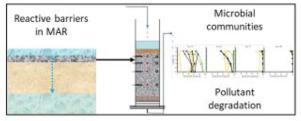Water Research ( IF 12.8 ) Pub Date : 2020-11-25 , DOI: 10.1016/j.watres.2020.116669 Jakub J. Modrzyński , Jens Aamand , Lea Wittorf , Nora Badawi , Valerie Hubalek , Arnau Canelles , Sara Hallin , Christian N. Albers

|
Groundwater is an important drinking water resource. To ensure clean drinking water, managed aquifer recharge (MAR) could be an attractive solution when recharging with treated wastewater. The installation of reactive barriers, e.g. with compost or other organic materials at MAR facilities, may improve pollutant removal. To link pollutant transformation processes and microbiology in reactive barriers, we simulated infiltration through different sand-compost mixtures using laboratory columns with depth-specific sampling of water and barrier material. We also evaluated the effect of inoculation with activated sludge. Our focus was on the simultaneous removal of organic micropollutants and nitrogen species, with parallel monitoring of the development of microbial communities. During 17 weeks of operation, the columns were fed with synthetic wastewater containing five organic micropollutants (1–2 µg/L each) and ammonium (2 mg N/L). Unique communities developed in the columns in relation to barrier material, with high effects of compost addition and minor effect of inoculation. Removal of the micropollutant paracetamol (acetaminophen) occurred in all columns, while sulfamethoxazole was only removed in columns with 50% compost. By contrast, limited removal was observed for sulfadiazine, carbamazepine and diuron, with the latter two displaying transient removal, attributed sorption. Oxygen was depleted within the top few cm of the columns when compost was present, but this was sufficient to remove all ammonium through nitrification. The fate of accumulated nitrate at deeper layers depended on the fraction of compost, with more compost leading to removal of nitrate by denitrification, but also by dissimilatory nitrate reduction to ammonium, hampering the overall nitrogen removal efficiency. Introducing compost as reactive barrier in MAR facilities has a large effect on the microbial communities and processes, but whether it will provide overall cleaner water to the underlying aquifer is uncertain and will depend very much on the type of pollutant.
中文翻译:

为控制含水层补给而开发的反应性屏障中的有机微量污染物和铵的联合去除
地下水是重要的饮用水资源。为了确保饮用水清洁,在对处理过的废水进行补给时,有管理的含水层补给(MAR)可能是一种有吸引力的解决方案。在MAR设施中安装反应堆肥,例如堆肥或其他有机材料,可以改善污染物的去除。为了将反应转化屏障中的污染物转化过程与微生物学联系起来,我们使用实验室色谱柱对深度不同的水和屏障材料进行采样,模拟了不同砂-堆肥混合物的渗透。我们还评估了接种活性污泥的效果。我们的重点是同时去除有机微污染物和氮物质,并同时监测微生物群落的发展。在手术的17周内,在色谱柱中加入了合成废水,其中包含五种有机微量污染物(各1-2 µg / L)和铵(2 mg N / L)。与屏障材料相关的列中形成了独特的群落,添加堆肥的效果很高,接种的效果也很小。在所有色谱柱中都去除了对乙酰氨基酚(对乙酰氨基酚)微污染物,而仅在堆肥浓度为50%的色谱柱中去除了磺胺甲恶唑。相比之下,对磺胺嘧啶,卡马西平和杜伦的去除效果却很有限,后两种显示出短暂的去除作用,这归因于吸附。当存在堆肥时,氧气会在柱顶数厘米内耗尽,但这足以通过硝化作用去除所有铵。深层累积硝酸盐的去向取决于堆肥的比例,堆肥较多会导致通过反硝化作用去除硝酸盐,还会通过将硝酸盐异化还原为铵盐,从而妨碍了整体脱氮效率。在MAR设施中引入堆肥作为反应性屏障对微生物群落和过程有很大影响,但是尚不确定能否为底层含水层提供整体清洁水,并且在很大程度上取决于污染物的类型。



























 京公网安备 11010802027423号
京公网安备 11010802027423号